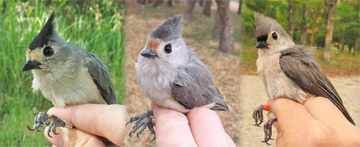 Photo ©
Claire Curry
Photo ©
Claire Curry
NestWatch Data in Action: Studying Hybridization in Titmice
Where the ranges of two closely related bird species overlap, individuals of each distinct species sometimes interbreed and produce hybrid offspring that are a mixture of both. Claire Curry (Ph.D. candidate, University of Oklahoma, Norman) is studying this phenomenon in Tufted and Black-crested titmice in Texas and Oklahoma to determine what exactly it is about the biology of these two species that enables them to interbreed and why this interbreeding results in a distinct zone where hybrid titmice occur.
“The titmouse system is great for studying the process of hybridization because there is an older hybrid zone in Texas, where the two forms have been interbreeding for thousands of years, while in southwestern Oklahoma the Black-crested Titmice have only recently arrived within the past 100 years following the expansion of mesquite trees due to fire suppression and overgrazing,” explains Curry. “I’ll be using NestWatch data to test if the two distinct species and their hybrids differ in their nesting success. This measure of evolutionary fitness is important to help distinguish among several theoretical models of why hybrid zones exist. Data gathered by NestWatchers will be an important piece of the puzzle when I combine it with behavioral data that I have also gathered.”
Wondering if you have seen a hybrid titmouse? Here’s what to look for. Hybrids in Texas are only found in a narrow strip about 25-30 miles wide that stretches from the Gulf Coast northward through Austin and past the western side of Fort Worth, and then extends to the west at the Red River. In Oklahoma, hybrids are only found in the extreme southwestern corner of the state from just west of the Wichita Mountains northwestward to the Texas panhandle. Crest color of hybrid titmice ranges from gray to jet black. The foreheads of hybrids typically are brown or chestnut, while Tufted Titmice have black foreheads and Black-crested Titmice have pale foreheads. Identification of hybrids is especially difficult at the edges of the hybrid zone because their plumage looks closer to that of the adjacent distinct species.
 Photo ©
Photo ©